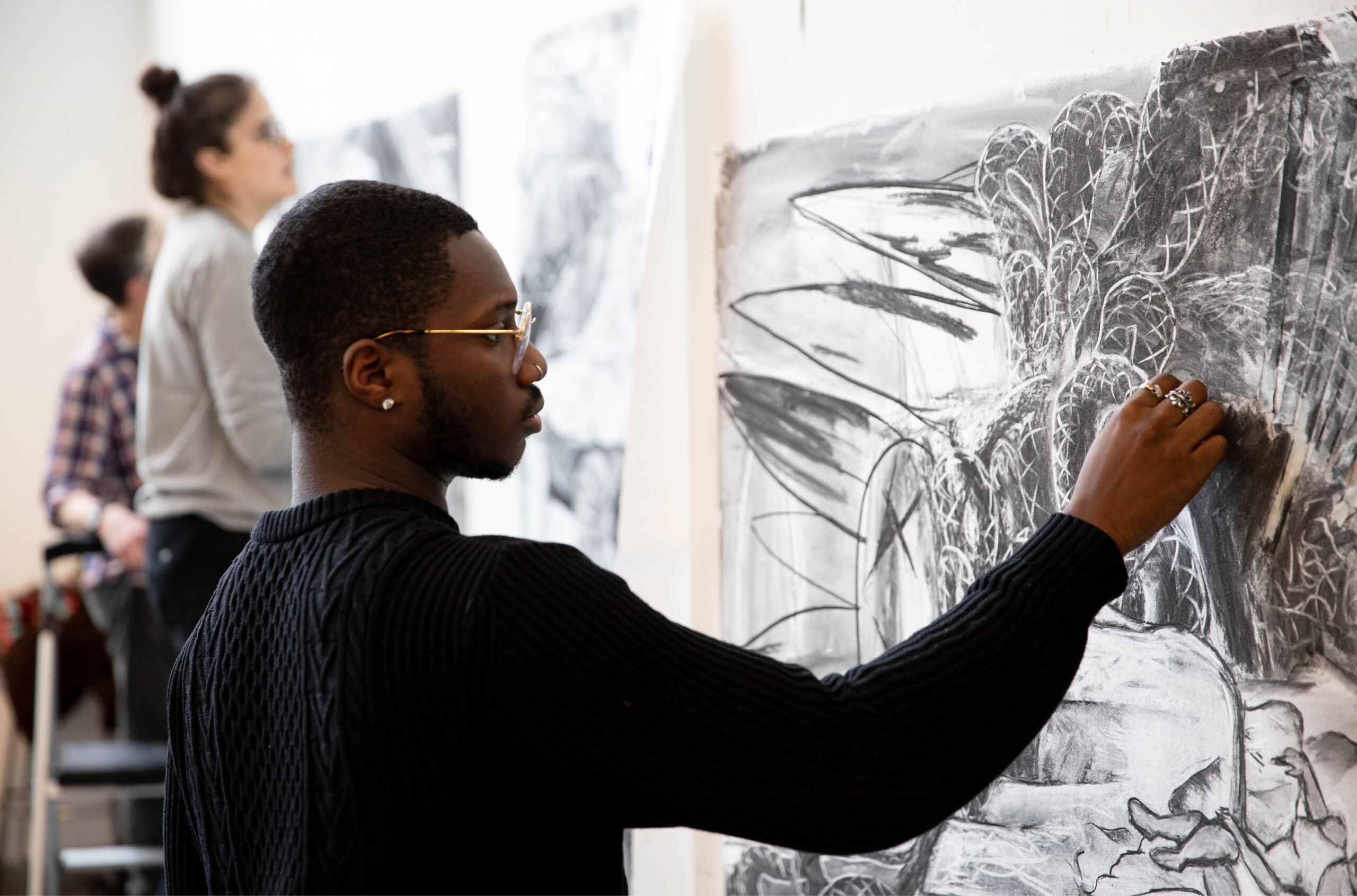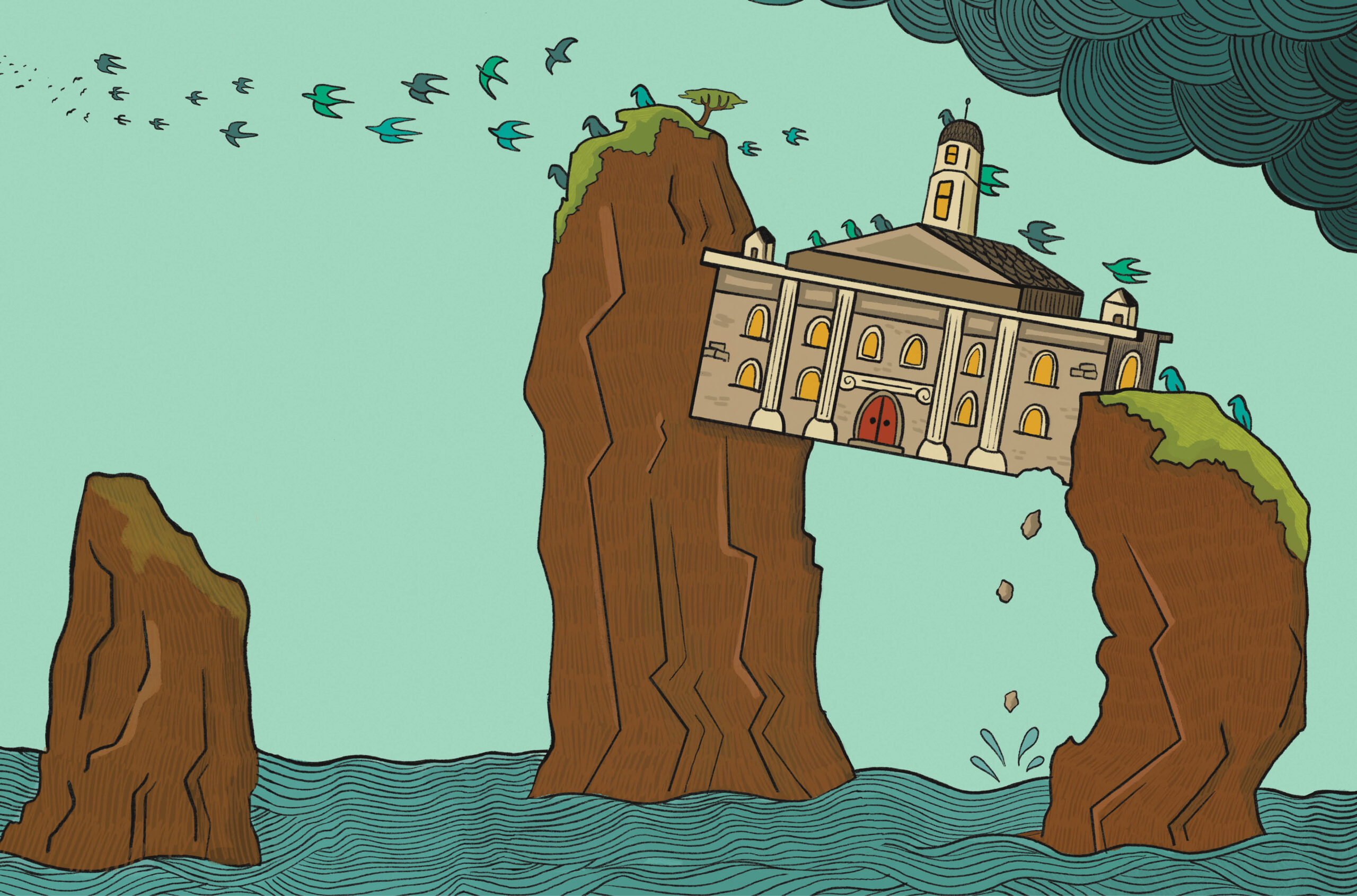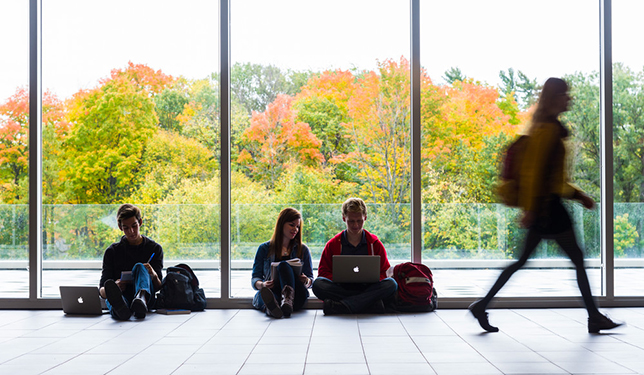Solving the male enrolment puzzle
In Canada and around the world, young men are opting out of postsecondary education. What are the long-term effects of the gender imbalance on campus –– and what can we do about it?

When Tia Lovegrove walked into her political science class on the first day of a new semester in January 2025 she was struck with a realization.
“There was only one male student in that class; out of 25, I saw one male student,” says Ms. Lovegrove, a fourth-year student completing a double major in political science and law, justice and society at Dalhousie University in Halifax.
Over the past four years, she has grown accustomed to seeing few males in her classes, particularly in law classes.
“In half my classes, we have barely any male enrolment,” says Ms. Lovegrove, who plans to pursue law school after she completes her undergraduate degree. “I feel like it’s almost normalized that if you’re going into these classes there’s not going to be very many male students in them; no one has really ever said anything.”
Ms. Lovegrove’s experience reflects a reality that Canada’s postsecondary institutions seem reticent to discuss: Campuses are dominated by female students while male enrolment has stagnated –– and it’s been happening for decades.
On average, postsecondary campuses consist of 56.1 per cent women and 43.9 per cent men, according to 2022-23 data from Statistics Canada.
In 2024-25, undergraduate students at Dalhousie consisted of 54 per cent females and 44 per cent males (with two per cent of students identifying as “other”). Female enrolment was slightly higher amongst graduate students, with 57 per cent females, 42 per cent males (one per cent identifying as “other”). By faculty, female undergraduates dominated in agriculture, architecture, arts and social sciences, health, science, dentistry, law and even medicine. Only the faculties of computer science, engineering, and management had higher male enrolment.
“We are aware of the ongoing challenges in achieving balanced gender representation across various fields of study,” a Dalhousie spokesperson wrote in an emailed statement to University Affairs. “We are committed to identifying and addressing barriers to ensure that all students, regardless of gender, feel supported in pursuing their academic and professional aspirations.” When asked whether the university has any specific measures to address the gender imbalance the spokesperson declined comment, reiterating that university administrators “monitor and measure many aspects of our enrolment data.”
At the University of Montreal, the numbers are considerably higher. A 2022 UdeMNovelles article noted that nearly seven out of every 10 students at the university were women. Statistics from 2024 are consistent with that figure, with over 67 per cent of students identifying as female.
“The statistics have been stable over the last few years, and it’s true that the trend has reversed, with more women than men in higher education,” wrote a University of Montreal spokesperson in an emailed statement. “It’s also worth noting that more girls are graduating from high school, so the pool of women applying to pursue their studies at university is correspondingly larger. The issue of gender-based recruitment is a sensitive one these days; that’s why we advocate that our recruitment strategies are as inclusive as possible.”
Back in the classroom, Ms. Lovegrove worries that student discussions at Dalhousie are often missing the male perspective.
“In a political science class, or focusing on big topics like human rights, I feel like you do have to have multiple perspectives to be able to fully understand such a big issue,” she says.
At Carleton University in Ottawa, Cara Gordon shares similar concerns.
“It’s definitely imbalanced; we kind of joke about it,” says Ms. Gordon, a third-year journalism and humanities student. “In humanities, we’re a class of about 30 right now and in my year I believe there’s six guys.”
In one of her seminar groups, which are intended to facilitate discussion, there are no males at all, she adds.
“I was thinking, ‘Would the guys bring something up that we wouldn’t think about?’” she says.
Things haven’t always been so lopsided in the journalism and humanities program, says Dr. Gregory MacIsaac, associate professor of humanities at Carleton.
“It wasn’t the case when the program started [in 2014]; almost half the class was men,” recalls Dr. MacIsaac, who helped to design the program, offered jointly by the university’s college of the humanities and journalism and communication school. “And then that started to go down slowly. Over the last three years, in a class of 30, there were like seven or five males.”
Dr. MacIsaac admits he’s perplexed by the dwindling male enrolment. Carleton University declined interview requests with their recruitment and enrolment team members and did not provide a statement about the imbalance of gender enrolment.
“It really has changed; I don’t know why,” he says. “It’s very tempting to come up with an easy answer and say, ‘Oh, well, you’re doing humanities and that just is soft,’ and it appeals to women more than men, but it’s rather insulting and sexist.”
In fact, findings from a recent study at the University of Zurich directly supports the theory that men selectively leave occupations and specializations, and devalue them, when the number of women in these jobs increases –– a concept sometimes called the “male flight theory.”
“When comparing two hypothetical occupations that are identical in all occupational characteristics and only differ in the share of female inflow (25% vs. 75%), the analysis shows that men are twice as likely to leave the feminizing occupation,” according to lead researcher Dr. Per Block, professor of sociology at the University of Zurich.
“Young males are dropping out of the labour force. They are dropping out of school. They are nowhere. They’re in their parents’ basements, and I think that’s very scary for the future.”
Long-term economic and social impacts
Miana Plesca, a professor in the department of economics and finance at the University of Guelph, doesn’t mince words about the state of male postsecondary enrolment.
“There are nearly two girls for every boy that graduates,” says Dr. Plesca of the overall female to male ratio. “Young males are dropping out of the labour force. They are dropping out of school. They are nowhere. They’re in their parents’ basements, and I think that’s very scary for the future.”
For the 2022-2023 academic year at Guelph, 60 per cent of undergraduate students were female. Dr. Plesca explains she has studied the trend with her students and the gender gap goes back decades.
“We went back with some students to the first year of the labour force survey, where we could find data –– in 1978,” she says. “Already in 1978 more women were graduating than men; it’s not a recent phenomenon.”
As a specialist in labour economics, Dr. Plesca says she’s concerned that males opting out of postsecondary education will have a hard time in the future labour market.
“Economists worry because of skill,” she explains. “Skill is ever more important; with AI and everything, low-skill jobs are getting obsolete and they’re getting replaced by robots, and you need high-skilled workers. And because of the university access, the high-skilled workers in the labour force are more likely to be female.”
Stagnating male enrolment is not just a Canadian issue. Dr. Claudia Buchmann is a distinguished professor of sociology at The Ohio State University. In 2013 she co-authored a book with Thomas A. DiPrete called The Rise of Women: The Growing Gender Gap in Education and What it Means for American Schools.
“This is pretty much a global trend,” says Dr. Buchmann. “In the book we have a map of the world that shows, at the time of writing, that for the majority of countries in the world, especially industrialized countries, now more women are enrolled in higher education and complete college degrees everywhere in the world. That was pretty striking to us.”
Like Dr. Plesca, Dr. Buchmann is concerned for the long-term economic well-being of men.
“By all arguments, the college degree still is very much an important piece of social mobility,” she says, noting that in the U.S., a college degree is ranked at the same academic level as a university degree.
Beyond potentially stunted earning potential, Dr. Buchmann worries about intangible gaps in male socialization.
“Think about what higher education can do in terms of being able to develop critical thinking, being able to be presented with diverse ideas or views from people who come from very different perspectives,” she says, adding that “Education for Citizenship” is her university’s motto. “It’s important to be in those social environments, interacting with someone that’s very different from you –– an international student or a student from a different part of the country, from a rural area versus an urban area.”
She points to worrisome ideologies in the U.S. which have been creeping into Canada as well.
“Schools are just a microcosm of what’s being reflected in the larger society,” she explains. “And in the United States right now, we have a really serious problem of the resurgence of this kind of patriarchal notion of ‘make America great again,’ and [the threat to] traditional family structures. And all of these things are, I think, largely due to the fact that some young men are feeling the decline in patriarchy has meant that they’re worse off and that women are to blame for that.”
Choosing a different path
So, what are young men doing if they’re not choosing to attend postsecondary institutions? In Canada, some are lured by the entry-level earning potential of the oil patch. Kyle Cyr, now 24, graduated from high school in Edmonton in 2019. Although he had respectable grades in high school and university was “definitely a possibility,” Mr. Cyr jumped at the chance to earn some good money instead.
“I ended up getting a job basically the weekend after I graduated, working just south of Edmonton in Nisku on an oil rig; I worked there for just over 10 months,” he says. “Jumping out of high school and then earning oil rig money, it was pretty crazy.”
Ultimately, he says the money wasn’t enough to keep him there for the long run.
So Mr. Cyr took on several roles, including as a barista at a climbing gym and a greenskeeper at a golf course, before finding work he loves at Rabbit Hill, a ski resort on the banks of the North Saskatchewan River. Today, as the terrain park supervisor, he manages staff and uses heavy machinery to build the jumps and rails for snowboarding.
“Being able to do a job that involves my passion, I couldn’t ask for anything else,” enthuses Mr. Cyr, who has been an avid snowboarder since the age of 12. “Obviously it doesn’t pay as well as some other jobs would, but at the same time, I’m willing to sacrifice that little bit of pay for waking up and actually being excited to go to work.”
“K to 12 should pay a bit more attention to why girls do better than boys in school –– pay more attention to pedagogy and see what makes boys more motivated and engaged.”
Kieran O’Donnell, 19, also opted out of college or university. While attending high school in Ottawa, he considered several career paths.
“I thought about going to other industries, like electrician, where you obviously need to go to college to get your certificates,” he recalls, adding he always did well in school despite not loving it. “I wanted to be a paramedic at one point; I had a bunch of ideas bouncing around.”
It was the thought of enduring more lecture-style classes that altered Mr. O’Donnell’s trajectory.
“I was just sitting in class and I thought, ‘I cannot do this for another two to four or whatever, how many years,” he says.
When he was 16, Mr. O’Donnell had worked with an interlock company as part of a high school co-op program. That experience turned out to be life-changing.
“I’m one of those kids who just can’t sit still; I’ve always got to be doing something,” he says. “Co-op was an amazing opportunity for me, as it was for many people, specifically males.”
While still in Grade 12, he launched his own contracting business –– O’Donnell Contracting –– specializing in interlock patios and garden beds. Like Kyle Cyr, Mr. O’Donnell loves the physical, outdoor nature of his work.
“One thing I love about my job is I’m outside,” he says. “I’m talking to people, I’m enjoying the beautiful summer; I just love what I do.”
Mr. O’Donnell notes that the financial investment required for a postsecondary education was a deterrent for him.
“Knowing I wanted to go into business and be making money, going into school to spend a bunch of money before you even made any seems like a step backwards for me,” he says. “I have no student debt. I’ve been working.”
Finding new ways to engage male students
Kyle Cyr and Kieran O’Donnell are examples of bright, young men who chose not to pursue postsecondary education. To encourage more men to continue their education, Dr. Plesca suggests the Canadian public school system should consider how boys learn differently compared with their female peers.
“K[indergarten] to [Grade] 12 should pay a bit more attention to why girls do better than boys in school –– pay more attention to pedagogy and see what makes boys more motivated and engaged,” says Dr. Plesca, who notes her own son struggled in the school system compared to her daughter. “I don’t think that girls perform better than boys once they graduate. I think they perform equally well. But K to 12 shows them [girls] as performing better because it rewards certain skills: They’re more organized, they’re more disciplined, they pay more attention.”
Extensive research on gender, mobility and college attainment support Dr. Plesca’s suggestions. In their report entitled The Secret Behind College Completion, published by the U.S. think tank Third Way, Dr. Buchmann and Columbia University professor Thomas A. DiPrete suggest that “because boys’ academic deficit is well established by middle school, reforms targeting the early and middle school years offer the greatest potential for closing the gender gap in college completion.”
The report goes on to say that a student’s academic future can already be forecast by the time they hit middle school, based on key indicators.
“We found that eighth grade grades are a very strong predictor, using nationally representative data, of the likelihood of persisting in college and getting a college degree,” says Dr. Buchmann. “These things start earlier than perhaps some people think.”
Dr. Buchmann also suggests there could be more teamwork between high schools and postsecondary institutions, to help bridge the gap for students who are on the fence.
“Colleges can do things like having summer preparation programs, or more collaboration with high schools,” she says. “Maybe take a class at the college level while they’re in high school and explore it.”
In light of widespread funding issues in North America and beyond, there are no strong indications that postsecondary institutions are interested in addressing the gender gap. To do so could be construed as discriminatory, argues Dr. Plesca.
“What are we going to do, put quotas?” asks Dr. Plesca. “If we put quotas, girls are going to sue us; if according to the admission criteria women look better than men, women might say, ‘No, this is discrimination.’ So, it’s a very slippery slope.”
Dr. Buchmann predicts the financial pinch currently being faced by U.S. colleges, partly due to declining enrolment and rising operating costs, will drive postsecondary institutions to offer more variety.
“Universities here [in the U.S.] are grappling with just how to stay in business, many of them; a lot of universities will probably fail in the next decade in this country,” she says. “So [they will need to consider] creating new programs, creating new certificate kinds of programs or new things that don’t require four years.
The hope, says Dr. Buchmann, is that these efforts will be enough to better engage male students.
“We need men and women in all of the fields that make up a healthy society and economy.”







Post a comment
University Affairs moderates all comments according to the following guidelines. If approved, comments generally appear within one business day. We may republish particularly insightful remarks in our print edition or elsewhere.
2 Comments
If for decades we have ignored and disregarded male students, if for decades we have “punished” them for not being able to sit quietly and do their work in elementary school, if for decades we have not attended to their developmental needs in high school, I don’t understand why we are suddenly surprised in 2025 that our young men have been disengaged and are not interested in the race towards what society deems to be success. Enrolment numbers for male students in post-secondary have been comparatively low for years! None of this is news. We kept telling our boys that they are not good enough because they underperform and underachieve; therefore we have raised men who shrug their shoulders in resignation. We cannot plant peas and reap corn! Haven’t we as a society reaped what we have sowed?
I published an article in University Affairs on Sept 1, 2015 related to this topic. It was entitled “Male – Female Imbalance in STEM Comes Down to Economics”. For some reason the search feature here does not seem to go back this far, but I can quote the final lines:
“Current educational policies focus on encouraging girls in math and science. What if we put the same energy into helping boys do better in all the other subjects? This would increase the proportion of women in STEM by giving boys an alternative. At the same time it might begin to address the other major equity problem in our universities – the severe under-representation of males.
Surely this is a policy we can all support.”
Well, I guess I was wrong. Since then Jordan Peterson has been vilified for encouraging young men to grow up, many young women are finding it impossible to find a partner they can respect, and our equity professionals remain uninterested.